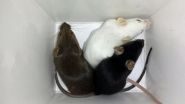Among patients who survive the immediate effects of subarachnoid hemorrhage (SAH) from a ruptured aneurysm, there is a risk of repeat hemorrhage, particularly within the first 24 hours. Because aneurysmal rebleeding is a significant cause of morbidity and death, in recent years institutions have shortened the time between hospital admission and treatment of aneurysmal SAH from longer than 7 days to fewer than 3 days.
To shorten this interval even more, the authors developed a new emergency treatment protocol for managing ruptured aneurysms within a few hours after a patient presents with aneurysmal SAH. To test the effectiveness of the new protocol, the authors compared the clinical courses of 442 patients treated in this manner between 2008 and 2011 with the clinical courses of 423 patients treated between 2001 and 2004 under a different protocol in which early treatment was defined as fewer than 3 days after the initial SAH.
There are a variety of ways to treat a ruptured aneurysm. At Kyungpook National University Hospital, the authors either filled the aneurysm with coils or placed a clip over the aneurysm neck. In each case the aneurysm is effectively blocked off from the vascular system and should no longer be at risk for bleeding.
Between 2001 and 2004, patients generally underwent catheter angiography within 24 hours after hospital admission to determine the cause of the SAH and to assess what treatment would be most appropriate. Treatment followed at a median of 49.4 hours for endovascular coil placement or 39.7 hours for surgical aneurysm clip placement after admission. Twenty-seven patients (6.4%) developed in-hospital rebleeding during this period.
Between 2008 and 2011, with the new emergency treatment protocol in place, patients underwent catheter angiography at a median time of 2.0 hours after hospital admission (and within 1 hour after a diagnosis of SAH was made). The appropriate treatment followed at a median of 2.9 hours for endovascular coil placement or 3.1 hours for surgical aneurysm clip placement after admission. The speed with which catheter angiography and treatment commenced following hospital admission did not differ significantly during daytime and nighttime hours. Eight patients (1.8%) developed in-hospital rebleeding during this period.
To adjust for differences between the two time periods with respect to patient age and sex, clinical grade at admission, severity of hemorrhage observed on CT scans, aneurysm size and location, treatment (aneurysm clipping vs. coil placement), and time interval from onset of SAH to admission, all patients were assigned a propensity score and then matched based on that score. The result was a closely paired cohort of 576 patients with small differences between groups (280 patients treated between 2008 and 2011, and 296 patients treated between 2001 and 2004).
In a comparison of the two patient groups, the authors found that the incidence of in-hospital rebleeding was significantly lower among patients treated under the new protocol: 6 (2.1%) of 280 patients treated between 2008 and 2011, and 22 (7.4%) of 296 patients treated between 2001 and 2004 (p = 0.003). In addition, the proportion of patients with favorable clinical outcomes (as measured using the modified Ranking Scale) 1 month after hospital admission was significantly higher among patients treated under the new protocol: 246 (87.9%) of 280 patients treated between 2008 and 2011, and 236 (79.7%) of 296 patients treated between 2001 and 2004 (p = 0.008).
The authors conducted similar comparisons between patients treated during the two time periods who presented at the hospital with "good" SAH grades and those who presented with "bad" SAH grades (based on the World Federation of Neurosurgical Societies' SAH grading scale). There was a significantly lower incidence of rebleeding and a significantly higher proportion of favorable clinical outcomes in patients with good SAH scores who received very early treatment. Although similar differences were found in patients who presented with bad SAH, these differences were not significant.
In addition to showing how patients treated with the new protocol fared better than those treated during an earlier period, the authors discuss how endovascular or surgical procedures can be performed even sooner after angiography and how antifibrinolytic therapy could be added to the management plan to reduce the risk of repeated hemorrhage.
INFORMATION:
Park J, Woo H, Kang DH, Kim YS, Kim MY, Shin IH, Kwak SG. Formal protocol for emergency treatment of ruptured intracranial aneurysms to reduce in-hospital rebleeding and improve clinical outcomes. Journal of Neurosurgery, published online, ahead of print, November 18, 2014; DOI: 10.3171/2014.9.JNS131784.
Disclosure: This study was supported by Grant No. A100870 from the Korea Healthcare Technology R & D Project, Ministry of Health & Welfare, Republic of Korea.
An editorial accompanies this paper: Zipfel GJ. Editorial: Ultra-early surgery for aneurysml subarachnoid hemorrhage. Journal of Neurosurgery, published online, ahead of print, November 18, 2014; DOI: 10.3171/2014.8.JNS141613.
For additional information, please contact:
Ms. Jo Ann M. Eliason, Communications Manager
Journal of Neurosurgery Publishing Group
One Morton Drive, Suite 200, Charlottesville, VA 22903
Email: jaeliason@thejns.org Phone 434-982-1209; Fax 434-924-2702
For 70 years, the Journal of Neurosurgery has been recognized by neurosurgeons and other medical specialists the world over for its authoritative clinical articles, cutting-edge laboratory research papers, renowned case reports, expert technical notes, and more. Each article is rigorously peer reviewed. The Journal of Neurosurgery is published monthly by the JNS Publishing Group, the scholarly journal division of the American Association of Neurological Surgeons. Other peer-reviewed journals published by the JNS Publishing Group each month include Neurosurgical Focus, the Journal of Neurosurgery: Spine, and the Journal of Neurosurgery: Pediatrics. All four journals can be accessed at http://www.thejns.org.
Founded in 1931 as the Harvey Cushing Society, the American Association of Neurological Surgeons (AANS) is a scientific and educational association with more than 8,300 members worldwide. The AANS is dedicated to advancing the specialty of neurological surgery in order to provide the highest quality of neurosurgical care to the public. All active members of the AANS are certified by the American Board of Neurological Surgery, the Royal College of Physicians and Surgeons (Neurosurgery) of Canada or the Mexican Council of Neurological Surgery, AC. Neurological surgery is the medical specialty concerned with the prevention, diagnosis, treatment and rehabilitation of disorders that affect the entire nervous system including the brain, spinal column, spinal cord, and peripheral nerves. For more information, visit http://www.AANS.org.

